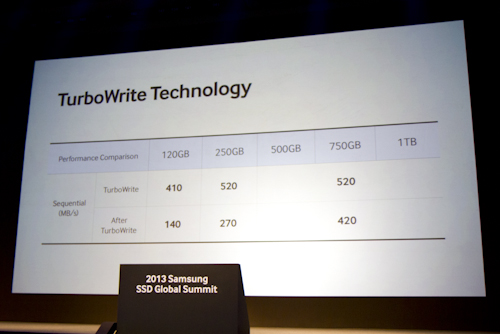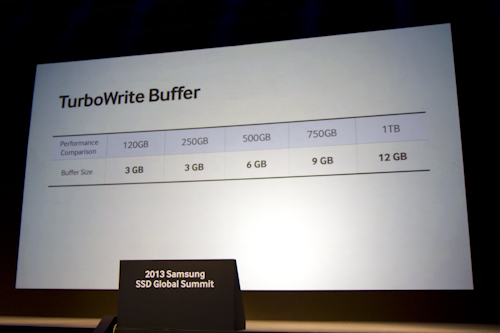Samsung's SSD Global Summit: The Leader In NAND Speaks Up
The theme of this year's Samsung SSD Global Summit, in Seoul, Korea, was SSDs For Everyone. More than 100 journalists from around the world showed up for this one-of-a-kind event, where we got a taste of the future in solid-state storage.
Advancements Beyond NAND
As we know, Samsung is in a unique position as an SSD manufacturer. The fact that it fabricates its own NAND means the company can cherry-pick the very best flash for those 840 Pros. It's also pushing the envelope with regard to lithography in a way that very few competitors can match. Consequently, Samsung's engineers also know where those solid-state drives come up short, giving them a problem to work on solving.
When you look at the spec sheet for pretty much any SSD family, you notice that the maximum performance levels are typically available from the highest-capacity models. At lower capacities, those throughput numbers trail off pretty fast. In fact, many drives under 100 GB bashfully offer sequential write rates in the low 100 MB/s range. Why? Usually, it comes down to the number of dies per memory package, and the controller's ability to utilize them all in parallel. As the density of flash increases, you need fewer dies to hit certain capacity points, and that can detract from performance. SSD vendors can use lower-density NAND for as long as it's still available, but that also drives prices up, which nobody likes.
This conundrum is exacerbated by triple-level cell flash. Capable of storing three bits for every memory cell, TLC NAND further increases density and reduces cost compared to MLC flash with two bits per cell. The price you pay is higher latency. TLC NAND takes longer to stabilize, which affects its performance.
To combat those compromises, Samsung introduced us to a couple of new technologies. The first is called Turbo Write. Think of this as an additional tier of storage space between the system RAM and TLC NAND. In effect, Samsung takes a small amount of the triple-level cell flash and treats it like SLC, or single-level cell memory. This reduces latency significantly, augmenting performance so long as the data you're working with is in that space.
Turbo Write increases performance across all capacity points, though the 120 GB configuration enjoys the largest boost. Claimed to improve sequential throughput by as much as 3x, this feature is key to extracting respectable benchmark numbers from a low-cost, lower-capacity SSD.
Samsung based the amount of NAND dedicated to Turbo Write on typical desktop workloads, it said. Even in the entry-level space, the 120 GB 840 EVO can maintain those impressive numbers across 3 GB of writes. That's more than enough for most folks. If you do routinely write more than that at a time, you might want to consider a true enthusiast-oriented SSD like the 840 Pro or one of its competitors.
Get Tom's Hardware's best news and in-depth reviews, straight to your inbox.
Current page: Advancements Beyond NAND
Prev Page NVMe In The Enterprise: 3 GB/s Sequential Reads? Next Page Advancements Beyond NAND, Continued-
ojas Well, i have 2.3 TB of writes and 4.36 TB of reads on my 120GB Intel 320 series SSD in the last year...no re-allocated sectors thus far.Reply
My 840 has about 0.41TB written to it, and i bought this drive a few months ago.
Anyway, looking forward to RAPID. -
Someone Somewhere @radiovan I read it as being that it's a replacement for AHCI/IDE - it'll still work with SATA.Reply
Anyone else find that this reads like an infomercial? -
Steveymoo Ahh Samsung, you're still not immune to the age old marketting technique of combining large breasted women with your technology, to catch men's eyes.Reply -
Onus Organizations with huge amounts of data to sift (e.g. Google, NSA, IRS) will want any speed they can get. Labs doing FCAT testing need ridiculous write speeds. For the rest of us, as individuals, if a bloated application like Word already loads in the blink of an eye, any faster simply doesn't matter. I hope a substantial focus can be placed on cost.Reply -
JPNpower CPUs GPUs are sort of slowing. this is the future. This is innovation at its hottest and fastest. Maybe it is competition as some say, as AMD is bogged down in processors, giving the leaders a healthy lead, but in flash, Samsung, Sandisk/Toshiba, and Micron are hot at it.Reply
Everyone wins. -
jabliese radiovan and SomeoneReply
NVMe is a protocol to work with PCIe. This is quite clear from the slides. What is PCIe? Do you remember your last video card upgrade? The slot your card plugged into was most likely a PCIe slot. NVMe has no business with SATA, and that's the way you want it to be. -
drewriley Reply11318974 said:No word on when we might be seeing the new vertical NAND in products?
Last year, Samsung touched on some new technologies that they were working on, but didn't share any insight during their latest summit,



